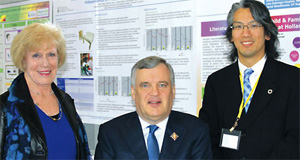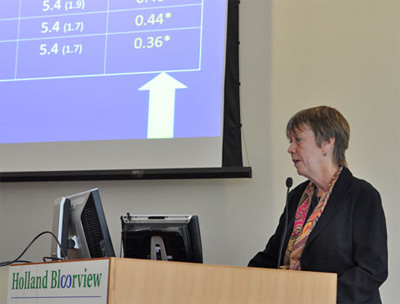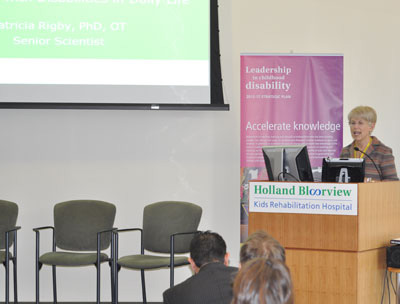We are pleased to provide you with an overview of the exciting work that was presented.

Latest research in autism
Study of brain development may lead to personalized behaviour treatment for kids with ASD
Autism Spectrum Disorder (ASD) is a complex condition that impacts normal brain development and affects a person's social relationships, communication, interests and behaviour. Because ASD is a spectrum disorder, there is wide variation in how it affects each person. Dr. Krissy Doyle-Thomas, a post doctoral fellow in the Autism Research Centre at Holland Bloorview, examined how three areas of the brain change with age to better target behaviour treatment and drug therapy for children with ASD. In the first study that spans childhood to adulthood, Dr. Doyle-Thomas scanned the brains of individuals with ASD between the ages of seven and 39 and compared changes with typically developing individuals of the same age to understand how autism affects the brain differently. The study found clear differences in the surface area, thickness in the outer layer of the brain (cortex) and differences in the chemistry of the brain between people with ASD and those without. Future studies will examine a wider spectrum of autism and use targeted drug therapy to help balance behaviours.
Latest research in communicative technology
Researcher uses hearing technology to help “locked-in” children communicate by “thought”
In Canada, there are more than 84,280 children with severe disabilities who have difficulty communicating with others. Some children use assistive technologies like voice or touch activated devices to communicate; however, others cannot. Eric Wan, a Master’s student in Electrical and Computer Engineering at the University of Toronto, has uncovered a way to use hearing technology to detect brain signals when a sound is introduced in the ear. The study tested the technology on people with the ability to communicate and found that the auditory technology was correct 70% of the time. Participants were asked to focus on a sound which would activate a switch, and to ignore a sound, which would translate to ‘off’. This technology has the potential to be used as a switch access for children with severe disabilities and can possibly replace other switch technology with a more portable auditory switch.
Latest research in integrating assistive technologies
Hands-on school-based study aims to support children, parents and teachers in switch training
For children with multiple and complex disabilities, assistive technologies can improve participation, engagement and independence. However, nearly 30 per cent of children stop using assistive technologies for a variety of reasons. The Infinity Lab at Holland Bloorview is an innovative pilot study at Toronto’s Sunny View Public School aimed at helping children master their switch by providing one-on-one training to children, parents and teachers within the school environment. The lab is staffed by a clinical engineer, a speech language pathologist and an occupational therapist who work collaboratively to select and design custom switch technology for each child. The team creates a more supportive learning environment by working alongside the children and teachers to train them on how to use the technology. By the end of the pilot, the team reported noticeable increases in the children’s mastered and emerging skills and a reduction in the time and effort required to support each child, teacher and parent. The hope is that the pilot can be used to change how children, teachers and parents are supported to learn switch technology and ultimately, to increase the uptake rate of the technology.
Latest research in parent – therapist communication

Questionnaire study uncovers opportunities to improve communication between parents and therapists
Parents of children with disabilities are periodically asked to complete a questionnaire to track their child’s functional skills in daily activities such as; self-care, mobility and social interaction. This information is used by rehabilitation therapists to understand a child’s current abilities and to set goals. A new study by Holland Bloorview senior scientist, Dr. Virginia Wright, compares two of the most commonly used tools to assess a child’s performance and explore parent’s experiences with these measures. Final results of the comparison of the measures’ performance are still pending. From the linked qualitative work that was done with one of the tools studied, the Pediatric Evaluation of Disability Inventory (PEDI), parents reported that setting goals and tracking progress provides an opportunity to explore what their child can do, understand when they are giving too much assistance, and be realistic about goals. That said, for some parents, the questionnaire can be a disappointing reminder when a child’s progress does not meet expectations and more work may be needed to better support the family in these instances. This study will lead to further examination of the magnitude and importance of change to parents and to use measurement tools as an important opportunity to improve communication, manage expectations and track progress for parents and therapists.
Latest research in inclusion
When inclusion might lead to exclusion: understanding the benefits and potential, unintended harms of inclusion.
In paediatric rehabilitation, helping children be included in society is considered a good thing, if not the ultimate goal. Gail Teachman, Clinical Associate at Holland Bloorview and a PhD candidate in the Graduate Dept. of Rehabilitation Science at University of Toronto, is exploring this assumption in her doctoral research by asking what inclusion means for youth with disabilities. Teachman shared a review of research showing that policies, practices and actions aimed at including children with disabilities have, in some cases, resulted in further marginalization of youth who were expected to 'fit' into mainstream settings by trying to be as 'normal' as possible. According to Teachman, more work needs to be done to understand what types of inclusion youth with disabilities desire, and in which settings.
Latest research in participation

Improving environments to encourage more children with disabilities to participate in leisure activities
Despite advances in policies designed to promote inclusion; children with disabilities are often excluded from participating in recreation and leisure activities and participate far less than other children. Dr. Patty Rigby, a senior scientist at Holland Bloorview Research Institute, and occupational therapist, is working on research to better understand the experiences of children with disabilities and how environmental factors, (e.g. physical, social, cultural attitudes, services and policies) influence children and their family’s participation in daily life. Barriers to participation can include the lack of additional social supports to help children participate, the lack of expanded transportation services to participate in after-school activities and sometimes physical barriers that prevent children from accessing a building. Dr. Rigby asks if we are doing enough to shape environments and services to meet the individual needs of children and their families. She hopes that by considering the influence of the environment when designing and evaluating services, more children will be encouraged to take part in meaningful and enjoyable experiences, resulting in greater inclusion in childhood activities, improved quality of life and long-term positive development benefits.